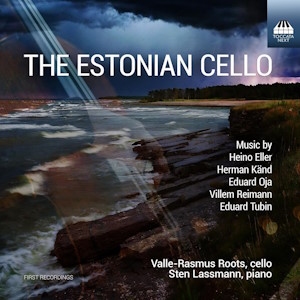
The Estonian Cello
Valle-Rasmus Roots (cello)
Sten Lassmann, (piano)
rec. 2023, International Arvo Pärt Centre, Laulasmaa, Estonia
Toccata Classics Next TOCN0033 [59]
This hour-long disc of Estonian sweetmeats reflects the influence of the School of Heino Eller. Eller wrote eight works for cello and piano and only two have been recorded before so here we have the full body of eight, allied to which there are pieces by his pupils, Eduard Oja and Eduard Tubin. Two students of Artur Kapp, the other leading Estonian composer and teacher, are also represented in the shape of Herman Känd and Villem Reimann.
Those looking for grit should look elsewhere as, with the exception of the Recitativo of Tubin’s unfinished Cello Concerto of 1955, which is heard in the piano score, much of the rest of the programme is clement, and decidedly salon-scaled. Eller’s pieces include the first Estonian work for the combination of cello and piano, The Old Dance of 1913, a lively affair with a Baroque feel. The Prelude in G major – brooding – and the Poem in A flat major – songful – are the two works that have been recorded before, so it’s pleasant to encounter those that were originally cast for piano (Evening Song and Prelude in E minor) but which were refashioned for cello. The Andante serioso has a stalking bass line that vests it with some terseness and the Ballade in E minor is much the longest work at eight minutes and goes through a number of moods, lively and capricious.
Eduard Oja’s Trilogy of Time dates from 1934 and whilst its portentous title may be rather forbidding it’s actually a brief three-movement piece lasting shy of six minutes. The stern opening is followed by the most pregnant movement, in which a repeated piano note, like the eternal clock, marks out our time. The energetic finale – ‘buffoonish’, says the notes (not sure I quite agree) – brings this attractive, if brief, piece to a close. Kapp’s students Känd and Reimann contribute wistful or gently attractive, lyric morceau of which Känd’s Ballade is the most interesting as it’s composed on a slightly more expansive canvas.
Tubin’s Cello Concerto torso is not simply the most advanced work here but its brooding power grows ever more dramatic and turbulent. Some of the cello writing is angular and dark, the piano encoding the projected orchestral accompaniment. The cello cadenzas are punctuated by these orchestrally conceived gestures with some force. It’s good news that this Recitativo movement has been recorded.
Both performers are well inside the music. Sten Lassmann has already recorded nine discs’ worth of Eller’s solo piano music for Toccata and so there’s no one better than he to take the piano role. Young cellist Valle-Rasmus Roots is a refined partner though, to be hyper-critical, I can imagine cellists with a greater range of tone colours.
Fine notes and a well-judged recording complete the disc. This is decidedly niche territory but that’s one of the reasons why labels like Toccata exist – to promote essentially new repertoire to disc in well-conceived and finely programmed releases such as this.
Jonathan Woolf
Buying this recording via a link below generates revenue for MWI, which helps the site remain free


Contents
Heino Eller (1887-1970)
Old Dance in G major (1913)
Prelude in G minor (1917)
Poem in A flat major (1921)
Evening Song in G major (piano orig. 1921)
Romance in G major (1924)
Andante serioso in D minor (1931)
Prelude in E minor (piano orig. 1942, arr. 1965)
Ballade in E minor (1944)
Eduard Oja (1905-1950)
Trilogy of Time for cello and piano (1934)
Villem Reimann (1906-1992)
Lullaby (c. 1930)
Herman Känd (1905-1952)
Poème d’amour (1933)
Ballade (1930s)
Eduard Tubin (1905-1982)
Cello Concerto (1955, unfinished): I. Recitativo

















